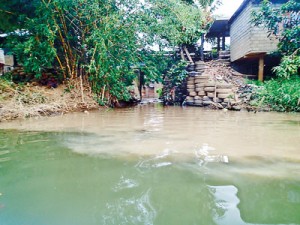News
Toxic waste water disposal goes on unchecked

A canal brings pollutants into the Kelani River. Note the difference in colour of the water
Industrial waste water and municipal sewage released untreated poses a danger to Sri Lanka’s environment, experts warn on the eve of World Water Day, which falls on Wednesday (March 22).
The theme this year is “waste water” with the campaign focusing on reducing and reusing waste water.
Globally, over 80 per cent of the waste water generated by society flows back into the ecosystem without being treated or reused, says a United Nation’s report. This has been the case even locally, water experts in Sri Lanka say.
“Most collected waste water in Sri Lanka is released to surface water bodies and eventually the ocean without any treatment. Even Colombo has so far only a sea outfall for its waste water,” says Pay Drechsel researcher at International Water Management Institute (IWMI).
A recent study by the Ministry of Environment in partnership with UNICEF and the International Union for Conservation of Nature (IUCN) reveals that pollution in the Kelani River basin is severe and industrial waste water as well as domestic waste water aggravates the pollution.
A separate study by the Environmental Foundation Limited to identify industries located along the river mapped facilities that discharge waste water to the river.
Service stations are another major waste water generating source, but the discharge goes directly to natural water sources.
These polluting industries and service stations should not be allowed on river and stream banks, says Kusum Athukorala of Sri Lanka Water Partnership. She suggests zoning laws that restrict these into industrial zones.
Apart from industrial polluters, there are also households which discharge their effluents into rivers and water bodies.
The World Health Organisation says in a 2014 report that 1.8 billion people use a source of drinking water contaminated with faeces, putting them at risk of contracting cholera, dysentery, typhoid, and polio. Unsafe water, poor sanitation and hygiene cause around 842,000 deaths each year.
“Too many toilets pits in business premises and houses in wayside communities such as Gampola and Pilimatalawa seem to lead directly into streams and rivers. “Trucks transporting sewage are often seen dumping loads into main rivers such as the Kelani in places such as Sedawatta,” said Kusum Athukorala, chairperson of Sri Lanka Water Partnership.
Most households rely on septic tanks or pit latrines. However, there are only very few treatment plants for human waste collected from these pits or septic tanks, once they fill up. Only 1 per cent of the excreta (fecal sludge) are treated. Due to the lack of dumping/treatment sites, illegal dumping in landfills is common, and surface and groundwater can get heavily polluted, points out IWMI researcher Drechsel.
Due to population growth, accelerated urbanisation and economic development, the waste water volumes and pollution are increasing globally.
This will be an issue for the proposed megapolis development, and experts say waste water management should not be neglected.
But there are ways to make use of waste water. Safely managed waste water is an affordable and sustainable source of water, energy, nutrients and other recoverable materials. There are many treatment processes and operational systems that will allow cities to use waste water to meet the growing water demand, support sustainable agriculture, and enhance energy production and industrial development.
Experts say treated waste water can be used safely for agriculture or service stations etc.
| Waste water has its uses Every time we use water, we produce waste water. According to UN Water, 80 per cent of all our waste water just flows back to nature untreated. Households should to try to reduce waste water, said Kusum Athukorala of Sri Lanka Water Partnership. And the waste water that is generated can be used for watering of plants and washing cars. |

